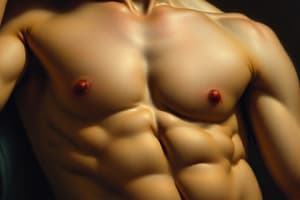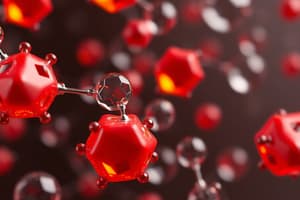Podcast
Questions and Answers
Testosterone is primarily produced in the adrenal glands.
Testosterone is primarily produced in the adrenal glands.
False (B)
Dihydrotestosterone (DHT) is directly responsible for sperm production.
Dihydrotestosterone (DHT) is directly responsible for sperm production.
False (B)
Androstenedione is a direct derivative of DHT.
Androstenedione is a direct derivative of DHT.
False (B)
Gonadotropin-Releasing Hormone (GnRH) is secreted by the pituitary gland.
Gonadotropin-Releasing Hormone (GnRH) is secreted by the pituitary gland.
Follicle-Stimulating Hormone (FSH) directly stimulates testosterone synthesis.
Follicle-Stimulating Hormone (FSH) directly stimulates testosterone synthesis.
High estrogen levels in men can be associated with gynecomastia.
High estrogen levels in men can be associated with gynecomastia.
Progesterone primarily enhances the effects of DHT.
Progesterone primarily enhances the effects of DHT.
Testosterone deficiencies always lead to increased libido.
Testosterone deficiencies always lead to increased libido.
Low testosterone levels have been linked to increased cardiovascular risk.
Low testosterone levels have been linked to increased cardiovascular risk.
Clomid is a medication used to decrease sperm production.
Clomid is a medication used to decrease sperm production.
Inhibin enhances the secretion of GnRH, FSH, and LH.
Inhibin enhances the secretion of GnRH, FSH, and LH.
Testosterone directly inhibits erythropoiesis.
Testosterone directly inhibits erythropoiesis.
High testosterone levels are commonly associated with PCOS in men.
High testosterone levels are commonly associated with PCOS in men.
LH stimulates Sertoli cells to produce testosterone.
LH stimulates Sertoli cells to produce testosterone.
Testosterone levels are consistent throughout the day.
Testosterone levels are consistent throughout the day.
Exogenous testosterone generally improves sperm production.
Exogenous testosterone generally improves sperm production.
Testosterone levels typically increase with age, promoting male fertility.
Testosterone levels typically increase with age, promoting male fertility.
Men who engage in regular heavy lifting tend to have lower testosterone levels.
Men who engage in regular heavy lifting tend to have lower testosterone levels.
Obesity tends to increase free testosterone levels in men.
Obesity tends to increase free testosterone levels in men.
Low testosterone enhances sperm motility.
Low testosterone enhances sperm motility.
Testosterone deficiency can lead to increased sperm DNA integrity.
Testosterone deficiency can lead to increased sperm DNA integrity.
TRT enhances endogenous testosterone production.
TRT enhances endogenous testosterone production.
The microenvironment of the testes requires high concentrations of testosterone for sperm development.
The microenvironment of the testes requires high concentrations of testosterone for sperm development.
Testosterone deficiency may lead to teratozoospermia, which is decreased abnormal sperm shapes.
Testosterone deficiency may lead to teratozoospermia, which is decreased abnormal sperm shapes.
Testosterone promotes spermatogenesis.
Testosterone promotes spermatogenesis.
Low systemic testosterone levels enhance sperm cell division.
Low systemic testosterone levels enhance sperm cell division.
Low LH/FSH enhances testosterone and sperm production.
Low LH/FSH enhances testosterone and sperm production.
Klinefelter syndrome results in naturally high levels of testosterone production.
Klinefelter syndrome results in naturally high levels of testosterone production.
Androstenedione directly regulates the formation of sperm cells.
Androstenedione directly regulates the formation of sperm cells.
Elevated levels of androstenedione cannot indicate any adrenal disorders.
Elevated levels of androstenedione cannot indicate any adrenal disorders.
Chronic androstenedione use can lead to increased natural testosterone production.
Chronic androstenedione use can lead to increased natural testosterone production.
Androstenedione reduces the risk of gynecomastia.
Androstenedione reduces the risk of gynecomastia.
Androstenedione leads to improved muscle mass in healthy men.
Androstenedione leads to improved muscle mass in healthy men.
Androstenedione supplements worsen lipid profiles.
Androstenedione supplements worsen lipid profiles.
GnRH directly acts on Leydig cells in the testes.
GnRH directly acts on Leydig cells in the testes.
FSH supports spermatogenesis.
FSH supports spermatogenesis.
LH stimulates Leydig cells to produce androgens.
LH stimulates Leydig cells to produce androgens.
Kallmann syndrome result in elevated GnRH.
Kallmann syndrome result in elevated GnRH.
Pulsatile GnRH is not needed for the testes to stay active.
Pulsatile GnRH is not needed for the testes to stay active.
GnRH's primary function is as a digestive enzyme.
GnRH's primary function is as a digestive enzyme.
Dihydrotestosterone (DHT) is directly produced in the testes and is not derived from testosterone.
Dihydrotestosterone (DHT) is directly produced in the testes and is not derived from testosterone.
Inhibin, secreted by Leydig cells, stimulates the release of GnRH, FSH, and LH to promote hormonal balance.
Inhibin, secreted by Leydig cells, stimulates the release of GnRH, FSH, and LH to promote hormonal balance.
Exogenous testosterone intake typically enhances natural sperm production due to the increased availability of the hormone.
Exogenous testosterone intake typically enhances natural sperm production due to the increased availability of the hormone.
Elevated levels of estrogens in men can potentially lead to conditions such as gynecomastia and prostate issues.
Elevated levels of estrogens in men can potentially lead to conditions such as gynecomastia and prostate issues.
Spermatogenesis requires a stable systemic presence of Testosterone, therefore levels found in blood are sufficient.
Spermatogenesis requires a stable systemic presence of Testosterone, therefore levels found in blood are sufficient.
Flashcards
Testosterone
Testosterone
Main male sex hormone; drives puberty, sperm production, muscle mass, bone density, libido, and red blood cell production.
Dihydrotestosterone (DHT)
Dihydrotestosterone (DHT)
Derived from testosterone; critical for fetal genital development and linked to male-pattern baldness and prostate enlargement.
Androstenedione
Androstenedione
A precursor to testosterone and estrogen, influencing hormonal balance.
Gonadotropin-Releasing Hormone (GnRH)
Gonadotropin-Releasing Hormone (GnRH)
Signup and view all the flashcards
FSH and LH
FSH and LH
Signup and view all the flashcards
DHEA/DHEA-S
DHEA/DHEA-S
Signup and view all the flashcards
Estrogens
Estrogens
Signup and view all the flashcards
Progesterone
Progesterone
Signup and view all the flashcards
Testosterone
Testosterone
Signup and view all the flashcards
Testosterone's Role in Puberty
Testosterone's Role in Puberty
Signup and view all the flashcards
Testosterone's Effect on Muscles
Testosterone's Effect on Muscles
Signup and view all the flashcards
Testosterone's Effect on Bones
Testosterone's Effect on Bones
Signup and view all the flashcards
Testosterone's Effect on Blood
Testosterone's Effect on Blood
Signup and view all the flashcards
Testosterone's Effect on Metabolism
Testosterone's Effect on Metabolism
Signup and view all the flashcards
Testosterone's Effect on Mental State
Testosterone's Effect on Mental State
Signup and view all the flashcards
HPG Axis
HPG Axis
Signup and view all the flashcards
Negative Feedback
Negative Feedback
Signup and view all the flashcards
Testosterone Production Site
Testosterone Production Site
Signup and view all the flashcards
Low Testosterone Symptoms
Low Testosterone Symptoms
Signup and view all the flashcards
Causes of Low Testosterone
Causes of Low Testosterone
Signup and view all the flashcards
Testing for Testosterone
Testing for Testosterone
Signup and view all the flashcards
Treatments for Testosterone Imbalance
Treatments for Testosterone Imbalance
Signup and view all the flashcards
Positive Effects of Testosterone on Sperm
Positive Effects of Testosterone on Sperm
Signup and view all the flashcards
Testosterone's Effect on Sexual Function
Testosterone's Effect on Sexual Function
Signup and view all the flashcards
Physical Benefits of Testosterone for Reproduction
Physical Benefits of Testosterone for Reproduction
Signup and view all the flashcards
Negative Effects of Low Testosterone on Sperm
Negative Effects of Low Testosterone on Sperm
Signup and view all the flashcards
Low Testosterone and Erectile Dysfunction (ED)
Low Testosterone and Erectile Dysfunction (ED)
Signup and view all the flashcards
Exogenous Testosterone Therapy
Exogenous Testosterone Therapy
Signup and view all the flashcards
Testosterone's Role in Spermatogenesis
Testosterone's Role in Spermatogenesis
Signup and view all the flashcards
Testosterone and Sperm Motility
Testosterone and Sperm Motility
Signup and view all the flashcards
Testosterone and Sperm Morphology
Testosterone and Sperm Morphology
Signup and view all the flashcards
Testosterone and Sperm DNA Integrity
Testosterone and Sperm DNA Integrity
Signup and view all the flashcards
Testosterone Deficiency and Spermatogenesis
Testosterone Deficiency and Spermatogenesis
Signup and view all the flashcards
Testosterone Deficiency and Estrogen Conversion
Testosterone Deficiency and Estrogen Conversion
Signup and view all the flashcards
Androstenedione's Role
Androstenedione's Role
Signup and view all the flashcards
Clinical Significance of Androstenedione
Clinical Significance of Androstenedione
Signup and view all the flashcards
Androstenedione Supplements Effect on Testosterone
Androstenedione Supplements Effect on Testosterone
Signup and view all the flashcards
Andro and Testosterone Levels.
Andro and Testosterone Levels.
Signup and view all the flashcards
Androstenedione's dangers.
Androstenedione's dangers.
Signup and view all the flashcards
The roles of GnRH
The roles of GnRH
Signup and view all the flashcards
Results of GnRH deficiency.
Results of GnRH deficiency.
Signup and view all the flashcards
Study Notes
- Male hormones, androgens, are vital for reproductive health, physical development, and overall well-being.
Primary Hormones
- Testosterone is the primary male sex hormone, mainly produced in the testes.
- Testosterone drives puberty, sperm production, muscle mass, bone density, libido, and red blood cell production.
- Dihydrotestosterone (DHT) is derived from testosterone and is crucial for fetal genital development.
- DHT may be linked to male-pattern baldness and prostate enlargement in adulthood.
- Androstenedione is a precursor to testosterone and estrogen and influences hormonal balance.
Regulatory Hormones
- Gonadotropin-Releasing Hormone (GnRH) is secreted by the hypothalamus.
- GnRH stimulates the pituitary to release Follicle-Stimulating Hormone (FSH) and Luteinizing Hormone (LH).
- FSH supports sperm production via Sertoli cells.
- LH triggers testosterone synthesis in Leydig cells.
Other Relevant Hormones
- DHEA/DHEA-S are adrenal precursors to testosterone and estrogen, with imbalances potentially disrupting hormonal equilibrium.
- Estrogens (Estrone, Estradiol) are present in small amounts in men.
- Elevated estrogen levels in men correlate with gynecomastia, obesity, and prostate issues.
- Progesterone balances DHT and estrone effects and supports nervous system calmness.
Functions and Imbalances
- Testosterone and FSH/LH regulate spermatogenesis and fertility in reproductive health.
- Deficiencies in testosterone and FSH/LH can cause infertility, low libido, or erectile dysfunction.
- Physical effects of testosterone maintains muscle mass, bone density, and fat distribution.
- Testosterone imbalances may lead to fatigue, osteoporosis, or weight gain.
- Low testosterone is linked to depression, irritability, and increased cardiovascular risk affecting metabolic and mental health.
Testing and Treatment
- Hormone panels (saliva or blood tests) evaluate testosterone, DHT, and estrogens.
- Hormone panels diagnose conditions like andropause or hypogonadism
- Treatments include hormone replacement therapy (testosterone, DHEA) or medications like Clomid to boost sperm production.
Regulation and Feedback
- Inhibin (from Sertoli cells) and testosterone suppress GnRH, FSH, and LH to maintain hormonal balance through negative feedback.
- Male hormonal health relies on a balance of androgens, regulatory hormones, and estrogens/progesterone.
- Disruptions in the hormonal system can affect fertility, physical vitality, and mental well-being.
Key Functions of Testosterone
- Testosterone drives fetal male genital development via conversion to DHT.
- Testosterone initiates puberty and maintains sperm production.
- Testosterone supports libido and erectile function in both sexes.
- Testosterone enhances muscle mass, strength, and recovery by promoting protein synthesis.
- Testosterone maintains bone density, which reduces osteoporosis risk.
- Testosterone stimulates red blood cell production.
- Testosterone regulates fat distribution and metabolism, and low levels correlate with metabolic syndrome.
- Testosterone influences mood, cognition, and energy levels.
Regulation of Testosterone
- The hypothalamus releases GnRH, and the pituitary secretes LH and FSH in the Hypothalamic-Pituitary-Gonadal (HPG) Axis.
- LH stimulates Leydig cells in testes to produce testosterone.
- FSH supports spermatogenesis via Sertoli cells.
- High testosterone inhibits GnRH and LH to maintain balance through negative feedback.
Production of Testosterone
- Testosterone is synthesized from cholesterol in Leydig cells in testes via enzymes (CYP11A1, 3β-HSD, CYP17A1).
- Small amounts of testosterone are produced in adrenal glands (both sexes) and ovaries (females).
Imbalances and Disorders
- Symptoms of low testosterone (hypogonadism) include reduced libido, muscle loss, fatigue, depression, and infertility.
- Causes of low testosterone are aging, obesity, and pituitary/testicular disorders such as Klinefelter syndrome.
- High testosterone in women is linked to PCOS (acne, hirsutism).
- High testosterone in men is rare; may indicate tumors or steroid abuse.
Testing and Management
- Diagnosis of testosterone imbalances involves blood tests (morning samples for accuracy).
- Blood tests measure total/free testosterone, LH, and FSH.
- Treatment includes hormone replacement therapy (HRT), lifestyle changes (weight loss, exercise), or medications like Clomid.
Gender Differences
- Women have lower testosterone levels (~10% of males).
- Testosterone supports bone health, libido, and muscle strength in women.
- Imbalances in women cause menstrual irregularities or virilization.
- Testosterone's multifaceted roles underscore its importance in overall health.
- Imbalances in testosterone require targeted clinical intervention.
Sperm Production via Testosterone
- Testosterone directly stimulates spermatogenesis (sperm production) in the testes.
- Higher testosterone levels exhibit increased sperm concentration (+46%) and total sperm count (+44%).
Sexual Function via Testosterone
- Testosterone maintains libido and erectile function by supporting nitric oxide production and vascular health.
Physical Health via Testosterone
- Testosterone supports muscle mass, bone density, and fat metabolism, indirectly benefiting reproductive health.
Negative effects of low testosterone
- Low testosterone correlates with decreased sperm count, motility, and DNA integrity.
- Men over 35 experience age-related declines in testosterone and semen parameters.
- Low testosterone impairs sexual arousal and erectile capacity (ED).
- Obesity and metabolic syndrome exacerbate testosterone deficiency, creating a cycle that further harms fertility.
Paradoxical Effects of Testosterone Therapy
- Exogenous testosterone (e.g., TRT) disrupts the hypothalamic-pituitary-testicular axis.
- TRT reduces FSH/LH secretion and halting natural sperm production, lowering sperm counts to near-zero levels.
- Sperm production may recover after discontinuing TRT, but recovery time varies.
Lifestyle and Environmental Influence
- Men engaged in regular heavy lifting or manual labor have higher testosterone levels and improved sperm parameters.
- Excess body fat lowers free testosterone and increases estrogen conversion, impairing fertility.
Age-Related Decline
- Testosterone levels decrease by ~1% annually after age 40.
- This decrease contributes to reduced semen quality and fertility
Testosterone Deficiency and Sperm
- Testosterone is essential for spermatogenesis (sperm formation) in the testes.
- Deficiency leads to decreased sperm count and may cause oligospermia (low sperm concentration) or azoospermia (absence of sperm).
- The testes require locally high testosterone concentrations for sperm development.
- Low systemic testosterone disrupts the microenvironment, impairing germ cell maturation.
Impaired Sperm Quality
- Low testosterone correlates with reduced sperm motility (movement capability).
- Deficiency increases abnormal sperm shapes (teratozoospermia), reducing fertilization potential.
- Testosterone deficiency elevates oxidative stress, causing sperm DNA fragmentation and compromising genetic material stability.
Hormonal Feedback Disruption
- Exogenous testosterone replacement therapy (TRT) suppresses the hypothalamic-pituitary-testicular axis.
- TRT halts endogenous testosterone and sperm production entirely.
Secondary Effects
- Low testosterone often coexists with obesity or metabolic syndrome.
- This situation exacerbates sperm dysfunction through inflammation and estrogen dominance.
- Age-related testosterone decline (starting around 35) progressively worsens semen parameters.
Clinical Evidence
- Men with testosterone deficiency have 30–50% lower sperm counts compared to those with normal levels.
- Borderline low testosterone levels correlate with suboptimal sperm health.
- Testosterone deficiency directly impairs testicular function.
- The direct impairment reduces sperm quantity/quality and disrupts hormonal regulation, all of which contribute to male infertility.
Impaired Spermatogenesis
- Testosterone is essential for maintaining the testicular microenvironment required for sperm formation.
- Deficiency disrupts germ cell maturation, leading to reduced sperm count (oligospermia) or complete absence (azoospermia)
- The testes rely on locally high testosterone concentrations (up to 100x blood levels) to support sperm cell division and maturation.
- Low systemic testosterone compromises the sperm cell division and maturation process.
Hormonal Axis Disruption
- Testosterone deficiency disrupts the hypothalamic-pituitary-gonadal (HPG) axis.
- This reduces luteinizing hormone (LH) and follicle-stimulating hormone (FSH) secretion.
- LH stimulates Leydig cells to produce testosterone, while FSH supports Sertoli cells in sperm nourishment.
- Low LH/FSH further exacerbates testosterone depletion and sperm production failure.
Abnormal Sperm Development
- Low testosterone correlates with poor sperm motility and increased abnormal morphology (e.g., misshapen heads, defective tails).
- This reduces fertilization potential.
- Oxidative stress from testosterone deficiency damages sperm DNA integrity.
- This increases fragmentation rates.
Secondary Effects of Androgen Deficiency
- Obesity-related testosterone deficiency increases estrogen conversion.
- This suppresses gonadotropin release and worsening spermatogenic dysfunction.
- Age-related decline (starting around 35–40 years) progressively reduces testosterone and semen quality.
Iatrogenic Suppression
- Exogenous testosterone replacement therapy (TRT) suppresses natural HPG axis activity.
- TRT halts endogenous testosterone and sperm production.
Clinical Evidence
- Men with low testosterone levels exhibit 30–50% lower sperm counts and 4–18% reduced normal sperm morphology compared to those with normal levels.
- In congenital conditions like Klinefelter syndrome, testosterone deficiency leads to testicular atrophy and irreversible infertility.
- Testosterone deficiency disrupts hormonal regulation, impairs sperm cell maturation, and degrades semen quality.
- This directly contributes to male infertility.
Biological Role of Androstenedione
- Androstenedione is produced in the adrenal glands and gonads (testes in males, ovaries in females).
- It serves as a precursor for synthesizing testosterone and estrogens (e.g., estrone) in the body.
Clinical Relevance of Androstenedione
- Elevated androstenedione levels may indicate adrenal disorders (e.g., congenital adrenal hyperplasia) or gonadal tumors.
- Androstenedione was marketed as a supplement to enhance muscle mass and erectile function, though clinical trials have questioned its efficacy.
Regulation and Effects of Androstenedione
- Androstenedione which regulates sexual differentiation, libido, and secondary sexual characteristics in both sexes - is part of the androgen family
- Androstenedione is a critical intermediate in steroid hormone metabolism, with clinical significance in diagnosing endocrine disorders and historical interest in performance enhancement.
Hormone Levels via Androstenedione
- Short-term supplementation (300 mg/day) transiently increases serum testosterone levels by ~34%, but levels often return to baseline within hours. (Men)
- Chronic use suppresses natural testosterone production via hypothalamic-pituitary-gonadal axis inhibition. (Men)
- Androstenedione converts to estrone via aromatase, elevating estrogen levels.
- This imbalance increases risks of gynecomastia (breast growth) and testicular atrophy. (Men)
- Androstenedione supplementation raises testosterone levels by ~200%, leading to masculinization effects (e.g., hirsutism, voice deepening). (Women)
- Conversion to estrone exacerbates hormonal imbalances, potentially causing menstrual irregularities and polycystic ovary syndrome (PCOS)-like symptoms. (Women)
Muscle Growth via Androstenedione
- Despite transient testosterone spikes, studies show no significant improvement in muscle mass or strength in healthy men.
- Hypogonadal men may see modest gains in fat-free mass and strength, but effects are dose-dependent and inconsistent
- Elevated testosterone may temporarily enhance muscle mass (Women).
- Gaining muscle can come as a cost of adverse effects like abdominal fat accumulation and virilization (Women)
Risks of Androstenedione
- Supplements worsen lipid profiles, reducing HDL ("good" cholesterol) and increasing LDL ("bad" cholesterol).
- Long-term use correlates with liver/kidney toxicity and increased cancer risk.
- In men, exogenous androstenedione reduces endogenous testosterone production, potentially causing infertility.
- Risks of hormonal imbalance, organ damage, and metabolic dysfunction outweigh potential gains.
GnRH Stimulation of Gonadotropins
- GnRH is released in pulsatile patterns from the hypothalamus.
- It triggers the anterior pituitary to secrete follicle-stimulating hormone (FSH) and luteinizing hormone (LH).
- FSH acts on Sertoli cells in the testes to support spermatogenesis (sperm cell maturation) and produce androgen-binding proteins.
- LH stimulates Leydig cells to produce testosterone, which is critical for sperm development and maintaining the testicular microenvironment.
Impact of GnRH Deficiency
- In conditions like Kallmann syndrome (GnRH neuron migration failure), low GnRH leads to hypogonadotropic hypogonadism (HH).
- Characteristics of the above include reduced FSH/LH, undescended testes, and absent sperm production.
- Without pulsatile GnRH, the testes remain prepubertal, with small volume
Studying That Suits You
Use AI to generate personalized quizzes and flashcards to suit your learning preferences.




